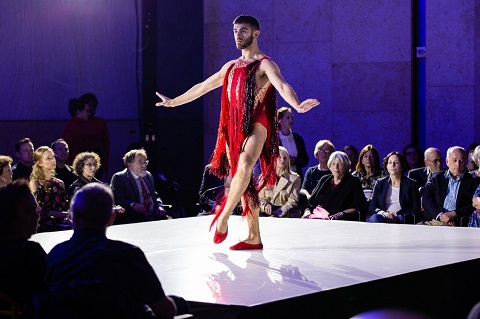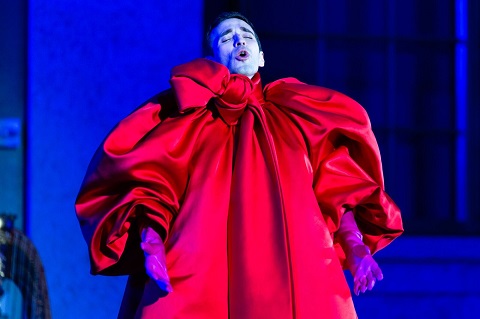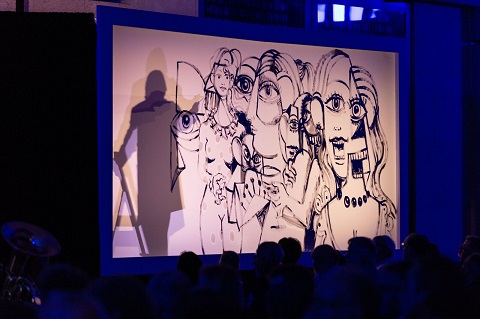
27 Sep 2018
O18 Magical Mystery Tour: Glass Handel
How to begin to quantify the wonderment stirred in my soul by Opera Philadelphia’s sensational achievement that is Glass Handel?
English Touring Opera are delighted to announce a season of lyric monodramas to tour nationally from October to December. The season features music for solo singer and piano by Argento, Britten, Tippett and Shostakovich with a bold and inventive approach to making opera during social distancing.
This tenth of ten Live from London concerts was in fact a recorded live performance from California. It was no less enjoyable for that, and it was also uplifting to learn that this wasn’t in fact the ‘last’ LfL event that we will be able to enjoy, courtesy of VOCES8 and their fellow vocal ensembles (more below …).
Ever since Wigmore Hall announced their superb series of autumn concerts, all streamed live and available free of charge, I’d been looking forward to this song recital by Ian Bostridge and Imogen Cooper.
The Sixteen continues its exploration of Henry Purcell’s Welcome Songs for Charles II. As with Robert King’s pioneering Purcell series begun over thirty years ago for Hyperion, Harry Christophers is recording two Welcome Songs per disc.
Although Stile Antico’s programme article for their Live from London recital introduced their selection from the many treasures of the English Renaissance in the context of the theological debates and upheavals of the Tudor and Elizabethan years, their performance was more evocative of private chamber music than of public liturgy.
In February this year, Albanian soprano Ermonela Jaho made a highly lauded debut recital at Wigmore Hall - a concert which both celebrated Opera Rara’s 50th anniversary and honoured the career of the Italian soprano Rosina Storchio (1872-1945), the star of verismo who created the title roles in Leoncavallo’s La bohème and Zazà, Mascagni’s Lodoletta and Puccini’s Madama Butterfly.
Evidently, face masks don’t stifle appreciative “Bravo!”s. And, reducing audience numbers doesn’t lower the volume of such acclamations. For, the audience at Wigmore Hall gave soprano Elizabeth Llewellyn and pianist Simon Lepper a greatly deserved warm reception and hearty response following this lunchtime recital of late-Romantic song.
Collapsology. Or, perhaps we should use the French word ‘Collapsologie’ because this is a transdisciplinary idea pretty much advocated by a series of French theorists - and apparently, mostly French theorists. It in essence focuses on the imminent collapse of modern society and all its layers - a series of escalating crises on a global scale: environmental, economic, geopolitical, governmental; the list is extensive.
For this week’s Live from London vocal recital we moved from the home of VOCES8, St Anne and St Agnes in the City of London, to Kings Place, where The Sixteen - who have been associate artists at the venue for some time - presented a programme of music and words bound together by the theme of ‘reflection’.
'Such is your divine Disposation that both you excellently understand, and royally entertaine the Exercise of Musicke.’
Amongst an avalanche of new Mahler recordings appearing at the moment (Das Lied von der Erde seems to be the most favoured, with three) this 1991 Mahler Second from the 2nd Kassel MahlerFest is one of the more interesting releases.
‘And there was war in heaven: Michael and his angels fought against the dragon; and the dragon fought and his angels, And prevailed not; neither was their place found any more in heaven … that old serpent … Satan, which deceiveth the whole world: he was cast out into the earth, and his angels were cast out with him.’
If there is one myth, it seems believed by some people today, that probably needs shattering it is that post-war recordings or performances of Wagner operas were always of exceptional quality. This 1949 Hamburg Tristan und Isolde is one of those recordings - though quite who is to blame for its many problems takes quite some unearthing.
There was never any doubt that the fifth of the twelve Met Stars Live in Concert broadcasts was going to be a palpably intense and vivid event, as well as a musically stunning and theatrically enervating experience.
‘Love’ was the theme for this Live from London performance by Apollo5. Given the complexity and diversity of that human emotion, and Apollo5’s reputation for versatility and diverse repertoire, ranging from Renaissance choral music to jazz, from contemporary classical works to popular song, it was no surprise that their programme spanned 500 years and several musical styles.
The Academy of St Martin in the Fields have titled their autumn series of eight concerts - which are taking place at 5pm and 7.30pm on two Saturdays each month at their home venue in Trafalgar Square, and being filmed for streaming the following Thursday - ‘re:connect’.
The London Symphony Orchestra opened their Autumn 2020 season with a homage to Oliver Knussen, who died at the age of 66 in July 2018. The programme traced a national musical lineage through the twentieth century, from Britten to Knussen, on to Mark-Anthony Turnage, and entwining the LSO and Rattle too.
With the Live from London digital vocal festival entering the second half of the series, the festival’s host, VOCES8, returned to their home at St Annes and St Agnes in the City of London to present a sequence of ‘Choral Dances’ - vocal music inspired by dance, embracing diverse genres from the Renaissance madrigal to swing jazz.
Just a few unison string wriggles from the opening of Mozart’s overture to Le nozze di Figaro are enough to make any opera-lover perch on the edge of their seat, in excited anticipation of the drama in music to come, so there could be no other curtain-raiser for this Gala Concert at the Royal Opera House, the latest instalment from ‘their House’ to ‘our houses’.
"Before the ending of the day, creator of all things, we pray that, with your accustomed mercy, you may watch over us."

How to begin to quantify the wonderment stirred in my soul by Opera Philadelphia’s sensational achievement that is Glass Handel?
How to even describe it without your thinking I am as bonkers as the mad Lucia I had seen at the festival earlier in the day? Let’s start in the venue, the long Annenberg Court that is the antechamber to the awesome Barnes Foundation art collection. (A gratis visit to the art was included in the evening.)
A small square stage platform is set in the center of the space, backed by two - count ‘em - two orchestras, a larger rectangular platform to the left, a raised platform with a large blank canvas to the right, beyond which are a bank of monitor screens. Chairs are placed around the space, set within a grid defined by blue lines. Rows of curious-looking, multi-colored dollies are parked at the ready. What could this wide-ranging spread possibly add up to?
Well, quite a lot as it turns out. Star counter-tenor Anthony Roth Costanzo, Visionaire, and Cath Brittan have conspired to present an artistic “happening” where singing, dance, fine art, and video are presented simultaneously to saturate the senses and create a one of a kind, on the spot experience. The 60-minute communal performance is anchored by the substantial interpretive gifts of Mr. Costanzo, and he sings magnificently, unstintingly, soulfully, and with unerring distinction of style alternating between Handel and Glass arias.
 Anthony Roth Costanzo in Glass Handel, costumed by Raf Simons for Calvin Klein. Photo Credit: Dominic M. Mercier.
Anthony Roth Costanzo in Glass Handel, costumed by Raf Simons for Calvin Klein. Photo Credit: Dominic M. Mercier.
Anthony’s pure, pointed vocalizing has gained a bit in vocal heft since last I heard him, without losing any of the haunting, spiritual quality that informs his entrancing tone. He is an uncommonly expressive interpreter, not so much singing the vocal lines as embodying them. His participation is not only seminal to the project, it rightly dominates and inspires it.
For the audacious concept is this: Three gifted dancers will simultaneously perform, and a renowned painter will create a work of art in immediate “reaction” or “interpretation” as the arias are being presented. Dance world’s lithe and athletic luminaries Patricia Delgado, David Hallberg, and Ricky Ubeda take turns cavorting tirelessly with practiced abandon on the second stage, nimbly executing Tony-winning Justin Peck’s evocative, impromptu-seeming choreography.
Artist George Condo enters during the opening Grand Parade of performers and supers to take his place behind the large framed canvas at the other stage. Back lit like a shadow box, Mr. Condo spends the hour in silhouette painting a huge, abstract, cubist-inspired sketch that eventually filled the space and seemed at times like a magical, highly refined Etch-a-Sketch. Further afield past this canvas, video monitors screened installations, especially created for the event.
 George Condo paints live at Glass Handel. Photo Credit: Dominic M. Mercier.
George Condo paints live at Glass Handel. Photo Credit: Dominic M. Mercier.
But wait, there’s more. Last year’s festival featured a premier of the opera We Shall Not Be Moved. In a reversal, the mantra of Glass Handel was that we SHALL be moved. Literally, and it happily turns out figuratively. For you see, fresh-scrubbed, attractive young supers manned those special dollies, and methodically moved audience members between the three staging locations. From the downbeat, a people shifter would put the dolly in place, put a hand on the shoulder to signal the intent to move the chair, tilt back and wheel the chair to a different vantage point. This was repeated with audience members in sequence.
I began directly in front of the singer, then went to the dance area, then finished in the painting area. While each had a different dynamic, all the while I was able to still enjoy the other concurrent elements. The hypnotic parade of spectators was itself a calculated element in the “performance art” nature of the project. As the music surged in the climactic aria, as the final touches and tweaks were daubed on the painting, and as the trio of dancers finally all assembled as one, the resettled audience had taken a mightily impressive “journey.” Although each element was exciting, it has to be said the real energizing presence of the evening was the towering, generous, inspiring contribution from Mr. Costanzo, first among equals.
There was so much to take in, we almost took for granted the two separate instrumental groups, one superbly essaying the Baroque glories of Mr. Handel, and the other restlessly, luminously liming the harmonies and pulsing rhythms of Mr. Glass. All this flash and dazzle would not have been possible without the dynamic and stylistically adroit conducting by Maestro Corrado Rovaris.
The technical elements were of necessity simple but competent, with Brandon Stirling Baker’s even lighting design solving many if not all of the challenges in lighting that space. Anthony’s costumes were over-the-top creations, starting with a red satin bell-shaped robe, with enormous puff sleeves that tied at the neck with an enormous billowing bow, contrasted with purple gloves. He eventually peeled that off to reveal a blue satin ball gown/shift emblazoned with Glass Handel, ending in a sort of androgynous white nightgown covered with Condo-like squiggles.
Did I mention it was revealed that the counter-tenor was prankishly wearing red satin high heels with rhinestone stripes under all that? The dancers were provocatively clad in the briefest of red briefs, with irregular rows of long red, silver, and black fringe creating cascades of visual movement. Completing the production “look,” the supers sported red tops and black slacks, while the black clad orchestra was accessorized with draped, wide red lanyards around their necks. This scintillating costume plot was created by Calvin Klein Chief Creative Officer Raf Simons. Kudos as well to stage manager Betsy Ayer who kept things flowing seamlessly.
I commend all concerned for taking this enormous leap of faith, this mighty artistic risk. There is much about this that portended that it shouldn’t work, but it did, and brilliantly, a stunning evening. The performers and creators were lavished with cheering ovations that called them back again and again. I am cheering them still: Bravi tutti!
James Sohre
Glass Handel
Music of George Frideric Handel
And Philip Glass
Countertenor: Anthony Roth Constanzo; Dancers: Patricia Delgado, David Hallberg’ Ricky Ubeda; Painter: George Condo; Conductor: Corrado Rovaris; Production: Anthony Roth Constanzo, Visionaire, Cath Brittan; Costume Design: Calvin Klein, designed by Chief Creative Officer Raf Simons; Choreography: Justin Peck; Videos: James Ivory and Pix Talarico, Mark Romanek, Tilda Swinton and Sandra Kapp, Tianzhou Chen, Daniel Askill, Maurizio Cattelan and Pierpaolo Ferrari, Rupert Sanders, AES+F, Mickalene Thomas; Lighting Designer: Brandon Stirling Baker; Production Format: Ryan McNamara; Video Consultant: Adam Larsen; Stage Manager Betsy Ayer; Rehearsal Director: Miguel A. Castillo